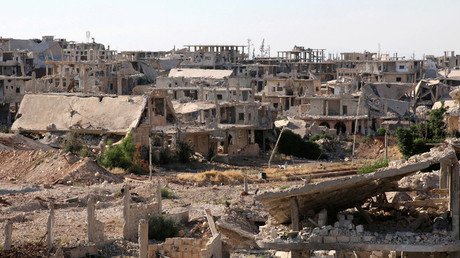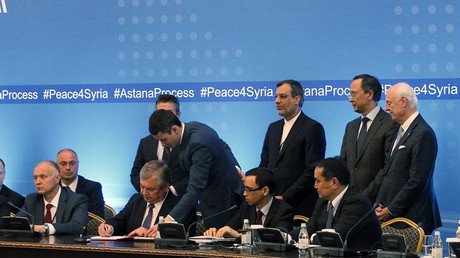Ceasefire deal brokered by Russia & US comes into force in southwest Syria

A major ceasefire deal agreed upon earlier by Russia, the United States, and Jordan has taken effect in the southwestern part of Syria. The truce to end hostilities and deliver aid to war-torn areas will be enforced by the three countries’ militaries.
The ceasefire and de-escalation agreement negotiated by Russia, the US, and Jordan on Friday took effect across southwest Syria on Sunday at noon Damascus time (09:00 GMT).
The truce extends to Syrian government forces and rebel groups in the provinces of Daraa, Quneitra, and Suwayda.
Commenting on the issue, Russian Foreign Minister Sergey Lavrov said that Russian, American, and Jordanian experts had worked out the details of the truce, which says the US and Russia bear shared responsibility in ensuring that the ceasefire is respected by all parties, the minister said.
Lavrov added that the ceasefire is aimed at getting aid deliveries through to war-ravaged areas and arranging contacts with opposition groups. A monitoring center in Amman, Jordan’s capital, will oversee the truce.
President Vladimir Putin, who discussed the issue with his US counterpart, Donald Trump, at the G20 summit in Hamburg, called the ceasefire agreement “a breakthrough, to a certain extent,” noting that the deal was made possible by Washington’s “more pragmatic stance” on working with Russia.
While little is known about how the truce will play out on the ground, it is understood that Russian, American, and Jordanian forces will be deployed to the area to stabilize the situation.
“In the first stage, Russian military police, as well as the Americans and the Jordanians, will ensure security around this de-escalation zone covered by the ceasefire,” Lavrov explained.
Russia’s foreign minister stressed that the ceasefire agreement clearly states that “Russia, Jordan, and the United States are committed to Syrian sovereignty and territorial integrity, as well as UN Security Council resolutions that pave the way to political reconciliation.”
The United Nations, in turn, has stated that it appreciates the international effort being made to bring lasting peace to this part of Syria.
“This is a step in the right direction,” UN Deputy Special Envoy for Syria Ramzy Ezzeldin Ramzy told reporters in Damascus, as cited by Reuters.
“All of this leads to supporting the political process,” he added.
EU foreign policy chief, Federica Mogherini, has also given the thumbs up to the Russia and US-brokered ceasefire.
“The implementation of these arrangements towards a nation-wide cessation of hostilities and unhindered humanitarian access is key to facilitate the intra-Syrian talks under UN-auspices in Geneva,” Mogherini said in a statement.
“The Syrian people can build peace and find their own path towards national reconciliation; but they need the international community and regional players to create the conditions for this to happen,” Mogherini said. The EU foreign policy chief added that the bloc was eager to provide such assistance.
Moscow has also engaged neighboring Turkey and Iran to push for the creation of safe zones in other Syrian provinces. The three countries adopted a memorandum on the creation of four security zones in Syria during peace talks in Kazakhstan’s capital, Astana, in early May.
Extremist groups, including Islamic State (IS, formerly ISIS/ISIL) and Jabhat al-Nusra (Al-Nusra Front), will be separated from the ‘moderate’ opposition in security zones set up in the cities of Idlib, Latakia, and Homs, as well as parts of Aleppo. Under the memorandum, all hostilities between government forces and the armed opposition should cease within the safe zones.
Checkpoints and observation posts will be installed along the de-escalation lines within the safe zones, which should provide free movement for unarmed civilians and humanitarian access to areas under the control of the guarantor states.
“The fact that the United States and the Russians have agreed on the ceasefire will make it more possible to be implemented,” Professor Seyed Mohammad Marandi of the University of Tehran told RT.
“The Iranians, the Syrians and the Russians believe that the more peace there is in Syria, the more pressure will be on the extremists to end the war, because ordinary people will see their lives back to some sort of normality,” he said.














